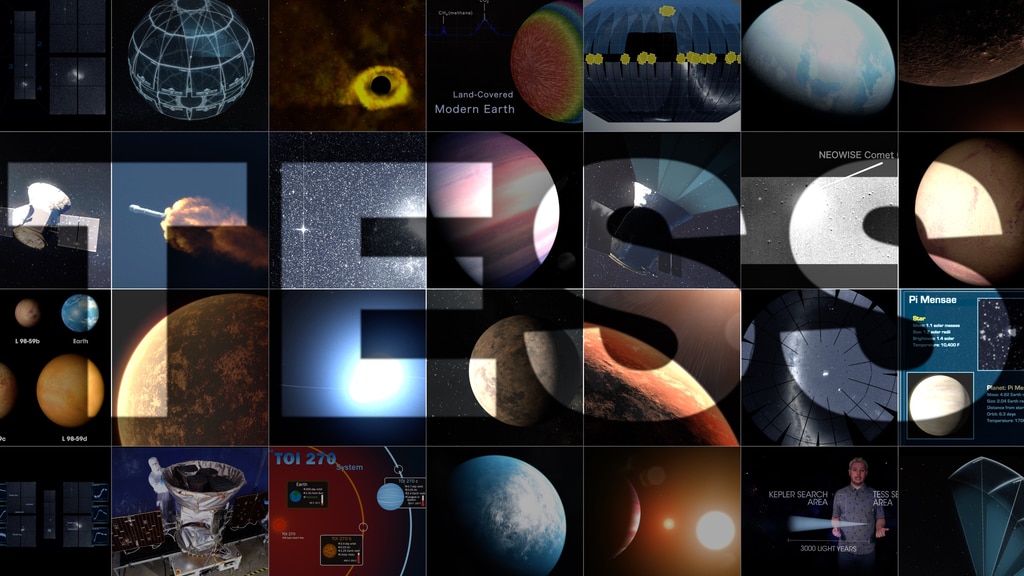NASA’s TESS Provides New Insights Into an Ultrahot World
Explore KELT-9 b, one of the hottest planets known. Observations from NASA's Transiting Exoplanet Survey Satellite (TESS) have revealed new details about the planet’s environment. The planet follows a close, polar orbit around a squashed star with different surface temperatures, factors that make peculiar seasons for KELT-9 b.
Credit: NASA's Goddard Space Flight Center
Music: "Migrating Species" from Universal Production Music
Watch this video on the NASA Goddard YouTube channel.
Complete transcript available.
Measurements from NASA’s Transiting Exoplanet Survey Satellite (TESS) have enabled astronomers to greatly improve their understanding of the bizarre environment of KELT-9 b, one of the hottest planets known.
Located about 670 light-years away in the constellation Cygnus, KELT-9 b was discovered in 2017 because the planet passed in front of its star for a part of each orbit, an event called a transit. Transits regularly dim the star’s light by a small but detectable amount.
Between July 18 and Sept. 11, 2019, as part of the mission's yearlong campaign to observe the northern sky, TESS observed 27 transits of KELT-9 b, and these observations allowed the team to model the system’s unusual star and its impact on the planet.
KELT-9 b is a gas giant world about 1.8 times bigger than Jupiter, with 2.9 times its mass. Tidal forces have locked its rotation so the same side always faces its star. The planet swings around its star in just 36 hours on an orbit that carries it almost directly above both of the star's poles.
The close orbit means the planet's dayside temperature is around 7,800 degrees Fahrenheit (4,300 C), hotter than the surfaces of some stars. This intense heating also causes the planet’s atmosphere to stream away into space.
Its odd host star is about twice the size of the Sun and averages about 56 percent hotter. But it spins 38 times faster than the Sun, completing a full rotation in just 16 hours. Its rapid spin distorts the star’s shape, flattening it at the poles and widening its midsection. This causes the star’s poles to heat up and brighten while its equatorial region cools and dims, a phenomenon called gravity darkening. The result is a temperature difference across the star’s surface of almost 1,500 F (800 C).
With each orbit, KELT-9 b twice experiences the full range of stellar temperatures, producing what amounts to a peculiar seasonal sequence. The planet experiences “summer” when it swings over each hot pole and “winter” when it passes over the star’s cooler midsection. So KELT-9 b experiences two summers and two winters every year, with each season about nine hours.
KELT-9 b begins its transit near the star's bright poles and then blocks less and less light as it travels over the star's dimmer equator. This asymmetry provides clues to the temperature and brightness changes across the star’s surface, and they permitted the team to reconstruct the star’s out-of-round shape, how it’s oriented in space, its range of surface temperatures, and other factors impacting the planet.
This sequence illustrates the KELT-9 b system. The planet orbits close to its star on a 36-hour orbit, which makes its dayside temperatures as hot as some stars. The planet’s atmosphere is streaming away into space. Its host star has a distorted shape caused by its rapid spin, which also produces a surface with multiple temperatures. The star's polar regions are both brighter and hotter than its midsection.
Credit: NASA's Goddard Space Flight Center/Chris Smith (USRA)
Illustration showing one possible interpretation of KELT-9 b.
Credit: NASA's Goddard Space Flight Center/Chris Smith (USRA)
This sequence illustrates how the KELT-9 b system is oriented from Earth’s point of view. The planet’s transits begin near one of the star’s hot, bright poles and progress toward the cooler, dimmer equator.
Credit: NASA's Goddard Space Flight Center/Chris Smith (USRA)
This sequence illustrates a year as experienced by KELT-9 b. Over the course of a single orbit, the planet twice experiences cycles of heating and cooling caused by the star’s unusual pattern of surface temperatures. Between the star’s hot poles and cool equator, temperatures vary by about 1,500 F (800 C). This produces a “summer” when the planet faces a pole and a “winter” when it faces the cooler midsection. So every 36 hours, KELT-9 b experiences two summers and two winters.
Credit: NASA's Goddard Space Flight Center/Chris Smith (USRA)

GIF animation illustrating KELT-9 b's weird seasons.
Credit: NASA's Goddard Space Flight Center
Illustration of KELT-9 b eclipsing its star, its trail of escaping atmosphere gradually engulfing the viewer.
Credit: NASA's Goddard Space Flight Center/Chris Smith (USRA)
Animation illustrating the unusual appearance of KELT-9 b’s host star. The star’s 16-hour rotation is about 38 times faster than the Sun’s, which flattens the star along its spin axis. This also makes the poles hotter and brighter than the broadened midsection, a phenomenon called gravity darkening.
Credit: NASA's Goddard Space Flight Center/Chris Smith (USRA)
Credits
Please give credit for this item to:
NASA's Goddard Space Flight Center. However, individual items should be credited as indicated above.
-
Producers
- Scott Wiessinger (USRA)
- Chris Smith (USRA)
-
Animators
- Chris Smith (USRA)
- Brian Monroe (USRA)
- Scott Wiessinger (USRA)
-
Science writer
- Francis Reddy (University of Maryland College Park)
-
Narrator
- Scott Wiessinger (USRA)
-
Editor
- Scott Wiessinger (USRA)
-
Scientist
- Johnathon Ahlers (USRA)
Missions
This page is related to the following missions:Series
This page can be found in the following series:Release date
This page was originally published on Tuesday, June 30, 2020.
This page was last updated on Thursday, January 25, 2024 at 10:49 PM EST.
